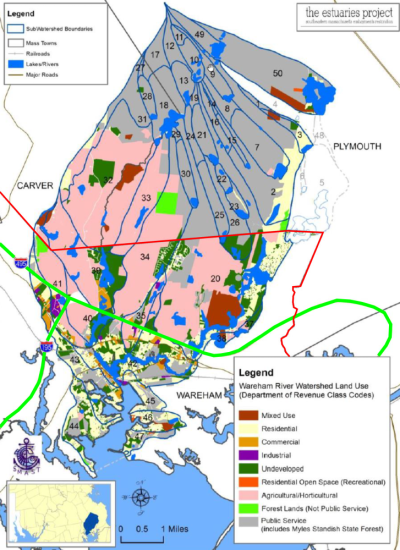State drafts nitrogen limits for Wareham watershed

The Massachusetts Department of Environmental Protection has released a draft report on how much nitrogen can safely be discharged into the Wareham River Estuary System and on how much additional nitrogen is currently making its way into the system.
Town officials say the findings will likely require many Wareham homeowners with septic systems to either connect to the town's sewer system or upgrade their systems to more expensive nitrogen-removal systems.
A public meeting to discuss the draft report will take place over Zoom on Tuesday, Nov. 28 at 2 p.m. Registration in advance is required; for instructions, visit bit.ly/warehamtmdlmeeting.
Despite an earlier announcement that the hearing would be in person in Town Hall, a Department of Environmental Protection representative has confirmed that no in-person element is planned.
"I think an in-person meeting could be pretty volatile," said Select Board member Alan Slavin. However, he added, "You have to engage with the public."
Excessive nitrogen in a watershed can lead to algae blooms, which crowd out other plant species in the ecosystem and damage fish and insect populations.
The Wareham River watershed, officially called the Wareham River Estuary System, is one of several in the town and includes an area extending well north into Plymouth and Carver. It is classified as "impaired" by excessive nitrogen, in part due to the loss of the critical habitat of eelgrass beds.
"Once the state has declared [a town's waters] impaired, which it has, the state has to develop a target nutrient budget, which [is] called [a] Total Maximum Daily Load," explained Rachel Jakuba, vice president of bay science with the Buzzards Bay Coalition.
"That's the amount of nitrogen that the watershed can put into the rivers and [have] those rivers be healthy," Jakuba said.
Locally controlled sources of nitrogen release 129.479 kilograms per day to the Wareham River watershed, according to the Department of Environmental Protection. The "locally controlled" figure excludes naturally occurring sources of nitrogen such as the nitrogen deposited by rainfall.
The draft nitrogen standards for Wareham set a target level — the "Total Maximum Daily Load" — at 165.52 kg/day overall and at 80.634 kg/day for locally controlled sources. This equates to a 37% reduction in the local source releases.
Of the locally controlled nitrogen pollution in Wareham, 43% comes from septic systems, and 20% comes from agriculture, primarily cranberry farming.
A recent report from the Buzzards Bay Coalition presents 10 years of research into the agricultural sources of nitrogen pollution — specifically, cranberry farms. The report includes proposed strategies for reducing that pollution by as much as 40%.
"The primary 'locally controllable' source of nitrogen to the Wareham River Estuary System is sanitary wastewater from septic systems," said Mason Saleeba, an analyst with the Department of Environmental Protection, in a letter to the town of Wareham.
A 79% reduction in the amount of nitrogen released by septic systems may be required to meet the new limits, according to modeling from the Department of Environmental Protection.
Multiple options are available for making that kind of reduction, including the expansion of the town's sewer system and individual homeowners installing upgraded septic systems.
"One of the key things that the town of Wareham is going to have to think through is: what are the costs of various options?" said Jakuba. "What is the cost of sewering homes, and how much nitrogen removal do you get from however many homes are selected?"
Bernie Pigeon, chair of the Sewer Commission, said the Commission is "not too involved" with the nitrogen standards at this point, but the involvement it does have is in trying to connect as much of the town as possible to sewer.
The sewer plant is "more economically able to get rid of the nitrogen from the effluent than a septic system is," said Pigeon.
The state regulations underpinning the nitrogen standards require owners of septic systems within a designated watershed to upgrade their systems within seven years of the adoption of a Total Maximum Daily Limit for nitrogen.
If the town applies for a watershed permit, committing to concrete plans to meet its nitrogen limits, it can exempt homeowners from the automatic septic system requirements, and it has more options and a longer timeline for making needed changes.
The Sewer Committee wants to have its comprehensive plan — a separate document from a watershed permit, but one that similarly outlines the town's planned sewage future — drafted by the end of December and ready for approval by Town Meeting in April, said Pigeon.













